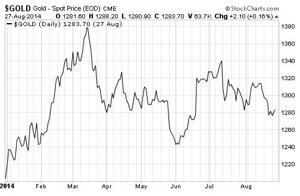For institutional investors, keeping secrets for long is an impossible task. The Securities and Exchange Commission requires these entities to file a 13F, a quarterly filing required of investment managers of assets of $100 million or more, which contains information regarding the asset manager’s investment style and potentially even a list of equities owned.
It’s a good gauge of what an investment company did in the last quarter. Taking a look back at prior quarters can paint a fairly accurate picture of what direction they’re assuming the market will take and how they’re positioning themselves to prepare – long, short, equities, derivatives, and so on.
When an investor like George Soros suddenly increases a bearish position by 605% in a quarter, it raises more than a few eyebrows.
For the quarter ending on June 30th, Soros Fund Management reported a large investment in puts, options that give an investor the right, but not the obligation, to sell a security at a given price, for an ETF that tracks the S&P 500.
Breaking Down Soros’ Position
Normally, a large investment firm will place hedges on positions, whether long or short, in order to mitigate risk. However, Soros increased his put position from 1.6 million to 11.29 million shares. That’s the equivalent of going from $299 million to $2.2 billion in notional value.
Skeptical investors dismiss any worries about an imminent market collapse due to the fact the Soros added to a few holdings like Facebook (NASDAQ:FB) and Apple (NASDAQ:AAPL) as well as added 182 brand new stocks. They believe his short position is simply a hedge or part of a longer term trading strategy.
I’m not sure it’s that simple. Soros’ total short position leaped from 2.96% to 16.65% making it the largest part of his holdings for the second quarter. That doesn’t sound like a hedge, it sounds like bearish speculation.
If we closely examine the stocks he did add to, it’s clear he’s preparing for a worst-case scenario. Soros doubled down on gold mining ETF’s and added plenty of gold-based companies to his portfolio. He increased his position in Market Vectors Gold Miners ETF to 2.05 million shares worth around $54 million from 1.16 million shares in the first quarter. He also established a call option investment worth 1.33 million shares of the Gold Miners ETF.
The gold addition is telling. Gold is an asset class that’s typically bought as a hedge against inflation or economic uncertainty. Real interest rates are in danger of becoming negative with the inflation rate at 2% and the yield on the 10-year treasury at around 2.33%. That means the inflation-adjusted rate of return is a scant 0.33%. If that figure declines, gold could see a rally, but that doesn’t appear to be Soros’s line of thinking.
The general consensus is that gold prices will actually fall in the next twelve months. Goldman Sachs estimates that gold will fall to $1,050 an ounce, a drop of nearly 19%. Speculators have pared back stakes in gold futures by 15% for the week ending August 5th as well.

So if Soros isn’t adding gold to his portfolio as a bullish sentiment, then the only reason left is as a hedge against a bear market. But one firm, albeit a well-known one, establishing hedges and speculating on a market declines isn’t enough for us to question the strength of the 5-year bull market yet.
Following In Soros’ Footsteps
George Soros is perhaps most famous for his trade made back in 1992 when he shorted the British Pound for a net gain of $2 billion and forced the Bank of England to devalue the currency. When he takes steps to leverage himself to profit from a downfall, investors tend to take notice.
Other major players share Soros’ feelings on gold. Hedge fund Pauslon & Co. owns 10.2 million shares of the SPDR Gold Trust (NYSEARCA:GLD) worth $1.21 billion and held on to his position for the second quarter making no new changes. Other companies have a bullish opinion about the precious metal as well like BlackRock Global and U.S. Global Investors. It’s enough to wonder what they know that Wall Street doesn’t.
Two of the most popular stocks for institutional investors have been Facebook and Apple, both of which were bought in greater numbers by numerous companies in the last quarter. At first glance, such a move may seem to indicate a bullish sentiment by so-called “smart money,” but there’s more to these companies than meets the eye.
Both companies have their attention on the Chinese marketplace as the next great growth opportunity. China’s market though, appears to be bracing for a fall. As counter-intuitive as it may sound, that doesn’t necessarily bode ill for these companies. The Chinese market has rallied on both good and bad news which could mean the government will step in with stimulus to support prices.
The world’s second largest economy is preparing for slowing growth and government intervention while the U.S. markets continue to hit new highs every week. There seems to be a disconnect on Wall Street and investors should be cautious.

To Follow, Or Not To Follow?
Many investors follow 13F filings as if it were a Wall Street cheat sheet. Following the moves of “smart money” should be a beneficial strategy according to their thinking process, but they fail to take into account several downsides.
First of all, the 13F reports are always a look back at what institutional investors did in the prior quarter, not a play-by-play breakdown of current strategies. Attempts to mimic a 13F means always being behind the curve.
The other big drawback is that hedge funds and other money management firm are often quite large and invest in ways that the retail investor cannot and should not. Strategies can include equities, bonds, derivatives, currencies, swaps, and other exotic instruments that work in tandem for large sums of money. Just to initiate a position in the futures market usually costs at least $50,000 making the strategies of firms investing in these markets much different than the appropriate strategies for every-day investors.
Still, there are takeaways to investment changes like the one’s Soros Fund Management made.
Concern for a market pullback is not just idle speculation. Here’s a few things to consider:
- Bull markets historically last about 5 years – 2014 marks year number 5 for the current bull run.
- The average S&P 500 P/E ratio is 15 while the current P/E is nearly 20.
- The strongest sector of the year has been Utilities, typically a defensive sector that performs well in recessionary stages, at 15% YTD.
- The weakest sector of the year has been Consumer Cyclicals, typically strong in market expansions, at just 0.23% YTD.
Combine these facts with the strong short moves George Soros made and a picture of a bear may begin to form in your head. Investors should consider this a warning notice to begin protecting your portfolio with appropriate hedges like covered calls and puts. Caution is recommended in this environment and you can be sure that we’ll be keeping a close eye on what Mr. Soros does in the third quarter this year.
No comments:
Post a Comment